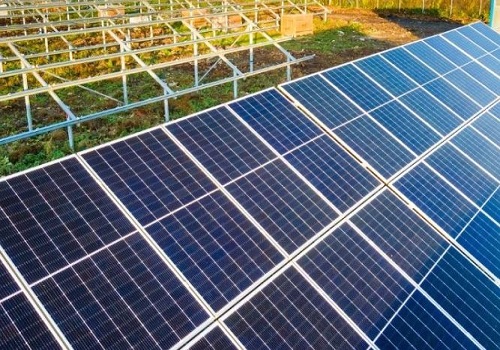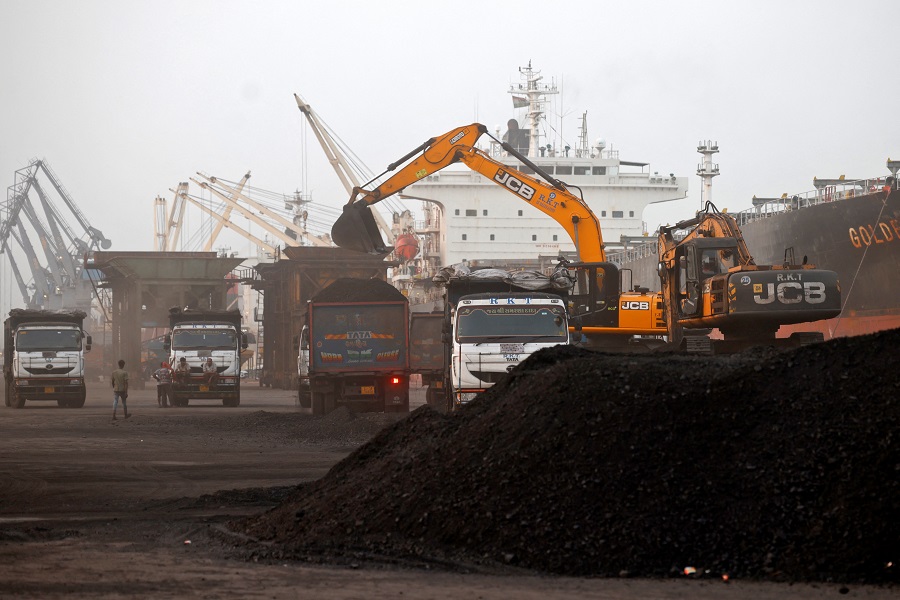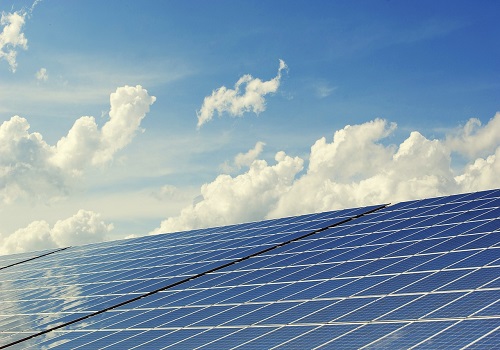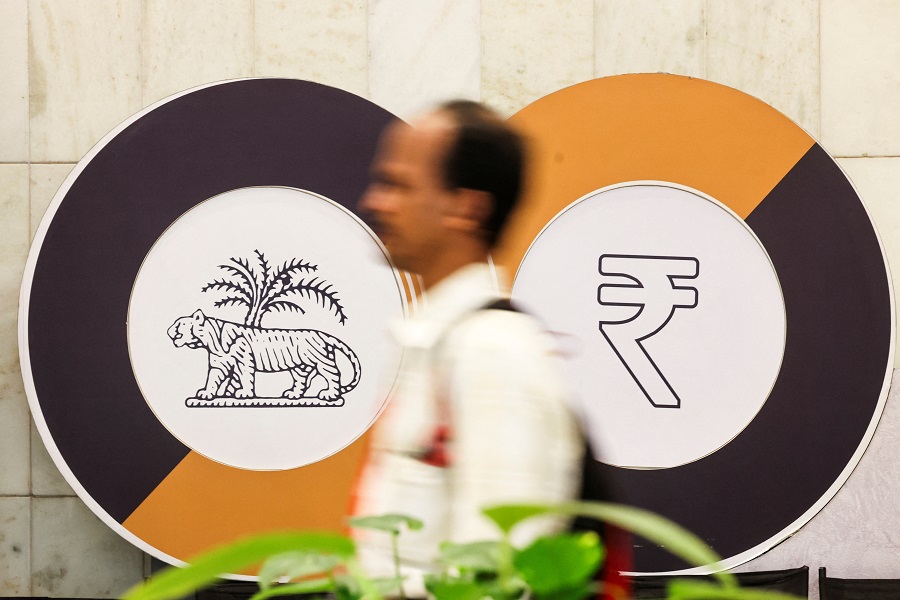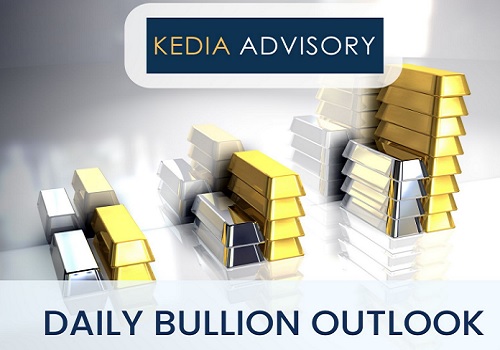Gold trading range for the day is 79150-79840 - Kedia Advisory

Gold
Gold prices rose by 0.43% to Rs.79,564, supported by increased safe-haven buying due to uncertainties in global trade policies and geopolitical tensions. President Trump's proposed tariffs on the EU, China, Canada, and Mexico, combined with inflationary risks tied to these policies, have driven demand for the precious metal. Additionally, the Federal Reserve's stance on maintaining higher interest rates to curb inflation added to market concerns. On the geopolitical front, traders monitored the delayed ceasefire agreement between Israel and Hamas. Central bank demand remained a key driver of gold's performance. Emerging markets led the buying spree, with Poland adding 21 tonnes to its reserves in November and India accumulating 8 tonnes during the same period, bringing its 2024 total to 73 tonnes. China's central bank also added to its gold reserves for the second consecutive month in December. Meanwhile, COMEX gold speculators raised net long positions by 17,994 contracts to 212,494 in the week ending January 14, signaling strong investor confidence in the metal. On the physical market, gold demand showed regional variations. India saw discounts of up to $30 per ounce due to rising domestic prices, while China experienced robust demand ahead of the Lunar New Year, with premiums ranging from $3 to $13 per ounce. Technically, the market is witnessing short covering, with open interest dropping by 3.96% to 8,813 contracts as prices rose by Rs.340. Gold is supported at Rs.79,355, with further support at Rs.79,150. Resistance is at Rs.79,700, and a break above could push prices toward Rs.79,840.
Trading Ideas:
* Gold trading range for the day is 79150-79840.
* Gold gains boosted by safe-haven buying as U.S. President Trump “is shaking things up” as the world marketplace nervously watches.
* Trump threatening to impose a 10% tariff on all Chinese imports starting on February 1.
* Gold stocks in COMEX-approved warehouses have jumped by a third in the past six weeks.
Silver
Silver prices slipped by 0.16% to Rs.91,944 as traders booked profits, although uncertainty surrounding U.S. President Trump's tariff policies and a softer dollar provided underlying support. Trump’s vow to impose tariffs on the European Union and consideration of a 10% tariff on Chinese imports added to market unease. The geopolitical tensions and anticipated Federal Reserve interest rate cuts have kept silver's appeal intact, with traders factoring in a potential rate cut by July and another by year-end. Supply concerns, particularly in London vaults, alongside strong industrial demand, continue to underpin silver prices. The Silver Institute projects a 4% reduction in the global silver deficit to 182 million ounces in 2024, as a 2% growth in total supply offsets a 1% demand increase. Record industrial demand from sectors such as electronics, electric vehicles, and solar panels, coupled with a recovery in jewelry consumption, is expected to drive demand to 1.21 billion ounces this year. However, a 16% decline in physical investment remains a limiting factor. On the supply side, mine production is forecasted to rise by 1%, with significant contributions from Mexico, Chile, and the U.S., while recycling is expected to grow by 5%. Technically, the market is under fresh selling pressure, with open interest rising by 2.65% to 21,069 contracts as prices declined by Rs.147. Silver is finding support at Rs.91,310, with a break below potentially testing Rs.90,680. Resistance is seen at Rs.92,560, and a move above this level could push prices toward Rs.93,180.
Trading Ideas:
* Silver trading range for the day is 90680-93180.
* Silver dropped on profit booking after seen supported boosted by uncertainty surrounding U.S. President Trump's policies.
* Trump said that his administration was discussing imposing a 10% tariff on goods imported from China on Feb. 1.
* Traders expect a quarter-point Fed interest rate cut by July, while another reduction by year-end is considered a coin toss.
Crude oil
Crude oil prices edged lower by 0.05% to Rs.6,561 as market sentiment was weighed down by U.S. President Donald Trump’s energy strategy, which aims to boost oil and gas production domestically. Trump’s declaration of a national energy emergency and plans to export U.S. energy globally raised concerns over a potential oversupply in an already competitive market. Adding to the mixed outlook, North Dakota’s oil output was reportedly down by 130,000 to 160,000 barrels per day due to extreme cold weather and operational disruptions. Citi raised its 2025 Brent crude oil forecast to $67 per barrel, up from $62, citing geopolitical risks linked to Iran and Russia. Meanwhile, U.S. crude inventories fell for the eighth consecutive week, declining by 1.961 million barrels, exceeding expectations of a 1.6 million-barrel draw. However, gasoline inventories surged by 5.852 million barrels, much higher than the expected 2.6 million-barrel build, while distillate stocks rose by 3.077 million barrels. Net U.S. crude imports also dropped by 1.304 million barrels per day. The Energy Information Administration (EIA) revised its 2024 U.S. oil production estimate to 13.55 million barrels per day, driven by growth in the Permian Basin. Technically, the market witnessed long liquidation, with open interest falling by 2.97% to 8,083 contracts. Crude oil finds support at Rs.6,520, with a break below potentially testing Rs.6,478, while resistance is seen at Rs.6,609, and a move above could push prices to Rs.6,656.
Trading Ideas:
* Crudeoil trading range for the day is 6478-6656.
* Crude oil dropped weighed down by U.S. President Trump's plans to boost US oil production.
* The new strategy to export American energy all over the world has raised concerns about oversupply in already competitive markets.
* North Dakota's oil production was estimated to be down by between 130,000 and 160,000 barrels per day due to extreme cold weather.
Natural gas
Natural gas prices rose by 4.52% to settle at Rs.340 as forecasts for colder weather suggested increased heating demand and potential output disruptions. The extreme cold is expected to boost daily gas demand to record highs, with LSEG predicting demand could reach 172.2 billion cubic feet per day (bcfd) on January 21, surpassing the previous record of 168.4 bcfd. The colder weather has already reduced production, with U.S. output dropping to a three-month low of 100.4 bcfd due to freeze-offs affecting wells and pipelines. Historically, similar freeze-offs have led to significant production declines, such as 20.4 bcfd during February 2021's cold wave. The U.S. Energy Information Administration (EIA) reported a withdrawal of 258 billion cubic feet (bcf) from storage for the week ending January 10, reducing inventories to 3,115 bcf. This marks the ninth consecutive weekly draw, with the most significant reductions in the South Central, Midwest, and East regions. Stockpiles are now 3.4% below last year’s levels, narrowing the surplus over the five-year average to 2.5%. The EIA's Short Term Energy Outlook projects U.S. dry gas production will rise to record highs, reaching 104.5 bcfd in 2025 and 107.2 bcfd in 2026, alongside increased LNG exports. Technically, the market saw short covering as open interest declined by 8.92% to 8,985 contracts while prices gained Rs.14.7. Natural gas has support at Rs.326.9, with a break below testing Rs.313.9, while resistance is seen at Rs.347.3, and a move above could push prices to Rs.354.7.
Trading Ideas:
* Naturalgas trading range for the day is 313.9-354.7.
* Natural gas gained on forecasts for colder weather than previously expected.
* Freeport LNG export plant in Texas shut due to power supply problems
* U.S. spot natural gas prices soared to multi-year highs with extreme cold expected to boost gas demand.
Copper
Copper prices fell by 0.3% to Rs.831.2 as market sentiment was impacted by U.S. President Donald Trump’s proposal to impose a 10% tariff on Chinese imports starting February 1, raising fears of a trade war. China’s foreign ministry expressed willingness to resolve differences through communication. Meanwhile, caution prevailed ahead of the Lunar New Year in China and key interest rate decisions by the U.S. Federal Reserve and the Bank of Japan. On the supply front, Chile lowered its long-term copper production forecast to 5.54 million tons by 2034, down from a previous estimate of 6.34 million tons. Meanwhile, Antofagasta reported a modest 1% increase in 2024 copper production to 664,000 metric tons, missing guidance due to lower grades. Data showed that China’s imports of unwrought copper and copper products surged 17.8% year-on-year in December to 559,000 metric tons, the highest in 13 months, reflecting refiners refilling inventories amid higher orders. In terms of the global market, the International Copper Study Group (ICSG) reported a refined copper market deficit of 131,000 metric tons in November, up from a 30,000 metric ton deficit in October. However, for the first 11 months of the year, the market showed a surplus of 168,000 metric tons, a sharp reversal from the deficit of 89,000 metric tons in the same period last year. Technically, the market experienced long liquidation as open interest dropped by 9.87% to 3,405 contracts. Copper prices are supported at Rs.828.8, with further support at Rs.826.4, while resistance is likely at Rs.833.8, and a break above could push prices to Rs.836.4.
Trading Ideas:
* Copper trading range for the day is 826.4-836.4.
* Copper dropped as U.S. President Trump said his administration was considering imposing a 10% tariff on Chinese imports from Feb. 1
* The global refined copper market showed a 131,000 metric tons deficit in November, compared with a 30,000 metric tons deficit in October.
* China's foreign ministry said Beijing was willing to maintain communication with the U.S. to "properly handle differences and expand mutually beneficial cooperation".
Zinc
Zinc prices dropped by 0.38% to Rs.275.15 as the global zinc market deficit narrowed to 52,900 metric tons in November, down from 65,400 tons in October, according to data from the International Lead and Zinc Study Group (ILZSG). For the first 11 months of 2024, the global market reflected a deficit of 33,000 tons, a significant shift from a surplus of 312,000 tons in the same period of 2023. Despite this, downside pressure was limited due to the continuing decline in LME-registered zinc inventories, which hit their lowest levels since February 2024. On the production side, China's refined zinc output increased by nearly 10,000 metric tons month-on-month in December, driven by maintenance recovery, production expansions in key regions like Shanxi, and new production facilities coming online. In January 2025, production is expected to rise by an additional 15,000 metric tons, or nearly 3%, as most regions ramp up output despite seasonal maintenance cuts in areas such as Hunan and Guangxi. On the demand side, signs of economic recovery in China are encouraging, with industrial output accelerating and credit aggregates gaining momentum, reflecting the impact of aggressive monetary stimulus by the People's Bank of China. Technically, the market experienced long liquidation, with open interest declining by 1.23% to 1,361 contracts. Zinc prices find support at Rs.273.7, with a break below possibly testing Rs.272.3. On the upside, resistance is seen at Rs.276.8, and a move above could push prices to Rs.278.5.
Trading Ideas:
* Zinc trading range for the day is 272.3-278.5.
* Zinc dropped as global zinc market deficit narrows in November fell to 52,900 metric tons.
* Trump mulls 25% duties on imports from Canada, Mexico on Feb. 1
* Trump wants to reverse the U.S. trade deficit with the EU
Aluminium
Aluminium prices declined by 0.29% to Rs.255.25 as inventories at major Japanese ports surged by 13.2% month-on-month in December, reaching 323,600 metric tons. Global aluminium production increased by 3% year-on-year to 6.236 million tons in December, according to the International Aluminium Institute (IAI). China's aluminium output also rose by 4.2% year-on-year to 3.77 million metric tons in December, boosted by new production capacity in Xinjiang. However, daily production decreased by 1.7% from November. Despite higher output, China's aluminium industry faced significant challenges as rising costs led to average losses of 687 yuan per ton, marking the first industry-wide loss in three years. For 2024, China's aluminium production reached 44.01 million tons, up 4.6% from the previous year. Meanwhile, exports of unwrought aluminium and related products from China grew by 17% in the first ten months of 2024, reflecting strong overseas demand. On the geopolitical front, the European Union plans to propose a ban on Russian primary aluminium imports as part of its 16th sanctions package over the Ukraine conflict. This could further tighten global aluminium supply, given the self-imposed shunning of Russian goods by manufacturers since 2022. Technically, the market saw long liquidation with a sharp 15.29% drop in open interest to 1,728 contracts. Aluminium prices are supported at Rs.254, with a break below potentially testing Rs.252.8. On the upside, resistance is likely at Rs.256.5, and a move above could see prices testing Rs.257.8.
Trading Ideas:
* Aluminium trading range for the day is 252.8-257.8.
* Aluminium dropped as stocks at Japanese ports rose by 13.2% by December end, from the previous month.
* Global primary aluminium output in December rose 3% year on year to 6.236 million tonnes - IAI
* The EU was set to sanction the import of primary aluminum from Russia in its upcoming package.
Cottoncandy
Cottoncandy prices declined by 0.32% to Rs.53,450, pressured by higher global production and ending stock projections for the 2024/25 crop year as highlighted in the recent WASDE report. Global cotton production is estimated to increase by over 1.2 million bales to 117.4 million, driven by larger crops in India and Argentina. Despite this, cotton arrivals in northern Indian states—Punjab, Haryana, and Rajasthan—have dropped 43% year-on-year, creating raw material shortages for ginners and spinners, especially in Punjab. Some farmers are withholding produce in anticipation of higher prices, limiting downside pressure. Domestic cotton consumption for the 2024/25 season is pegged at 313 lakh bales, while cotton pressing is projected to remain steady at 302.25 lakh bales. India’s cotton imports are expected to rise to 25 lakh bales, up by 9.8 lakh bales from the previous season, with 9 lakh bales having already arrived at Indian ports by November 30, 2024. Ending stocks for 2024/25 are forecast at 26.44 lakh bales, lower than the 30.19 lakh bales recorded last year. Globally, cotton consumption is expected to rise, supported by increased demand in India, Pakistan, and Vietnam, while world trade is marginally higher due to export gains in Brazil and Benin. Technically, the market witnessed long liquidation, with open interest dropping 9.43% to 240 contracts. Prices are now supported at Rs.53,130, with further downside potentially testing Rs.52,800. Resistance is seen at Rs.54,020, and a move above this level could push prices towards Rs.54,580.
Trading Ideas:
* Cottoncandy trading range for the day is 52800-54580.
* Cotton dropped as WASDE report projected higher production and ending stocks for the 2024/25 crop year
* India's cotton production in 2024/25 is likely to fall by 7.4% from a year ago
* Cotton production is projected to increase in China, Brazil, and Argentina, more than offsetting reductions in the US and Spain – USDA
* In Rajkot, a major spot market, the price ended at 25697.55 Rupees dropped by -0.17 percent.
Turmeric
Turmeric futures fell by 0.39% to settle at Rs.14,300 as harvesting began in Karnataka and Andhra Pradesh, with Telangana expected to follow soon. The increased supply from the new crop post-Makar Sankranti is anticipated to weigh on prices. However, downside pressure was limited due to concerns over lower rhizome growth and reduced yield expectations, prompting close monitoring of the harvesting progress. Supply constraints persist in key markets like Erode and Warangal, with reduced availability and pending delivery obligations in futures markets. Additionally, new crop arrivals are not expected until April, while unfavorable weather conditions, including El Niño's impact, continue to pose risks to production. Despite these challenges, domestic consumption remains high, and international demand supports elevated prices. Last year’s production stood at approximately 68-70 lakh bags, against domestic consumption of 128 lakh bags, leaving old stocks nearly depleted. Exports have been robust, with turmeric shipments rising by 6.57% year-on-year to 108,879.96 tonnes during April–October 2024, compared to 102,162.90 tonnes in the same period of 2023. October exports increased by 57.22% year-on-year, reflecting strong international demand. Technically, the market witnessed long liquidation, with open interest dropping by 0.18% to 11,315 contracts as prices declined by Rs.56. Immediate support lies at Rs.14,208, with further downside possibly testing Rs.14,118. Resistance is expected at Rs.14,414, and a move above this level could push prices toward Rs.14,530.
Trading Ideas:
* Turmeric trading range for the day is 14118-14530.
* Turmeric dropped as harvesting has commenced in Karnataka and Andhra Pradesh and is expected to commence in Telangana.
* However downside seen limited amid concerns over slow growth of rhizomes and low yield estimates persist.
* With the arrival of new crop likely to increase after Makar Sankranti, supply is expected to increase.
* In Nizamabad, a major spot market, the price ended at 13955.9 Rupees gained by 0.03 percent.
Jeera
Jeera futures rose by 0.27% to settle at Rs.22,625 due to low-level buying, supported by stock shortages. However, gains were capped as demand remained subdued, and current export requirements were fulfilled by existing inventories. Farmers reportedly hold about 20 lakh bags of jeera, of which only 3-4 lakh bags are expected to trade by season's end, leaving a substantial carry-forward stock of approximately 16 lakh bags. India's cumin production for the 2023-24 season reached 8.6 lakh tonnes from an area of 11.87 lakh hectares, significantly higher than the previous year's 5.77 lakh tonnes from 9.37 lakh hectares, according to the Spices Board. Indian cumin remains the cheapest globally, priced at $3,050 per tonne, making it an attractive option for importers, including China. International demand for Indian cumin has surged, aided by tensions in the Middle East, boosting business for exporters in Gujarat. Jeera exports from April to October 2024 rose sharply by 77.37% to 135,450.64 tonnes compared to 76,367.90 tonnes in the same period of 2023. Exports in October alone increased by 161.04% year-on-year, reflecting robust global demand. Technically, the market experienced short covering as open interest declined by 1.96% to 2,253 contracts, while prices rose by Rs.60. Jeera is finding immediate support at Rs.22,500, with the next support level at Rs.22,360. Resistance is likely at Rs.22,730, and a move above this could push prices toward Rs.22,820.
Trading Ideas:
* Jeera trading range for the day is 22360-22820.
* Jeera gains on low level buying amid shortage of stocks is contributing.
* However upside seen limited as demand is low and the current export business is being met from the available stock.
* The current season is expected to have similar production levels as last year due to better crop conditions and good sowing.
* In Unjha, a major spot market, the price ended at 23309.25 Rupees dropped by -0.33 percent.
Views express by all participants are for information & academic purpose only. Kindly read disclaimer before referring below views
